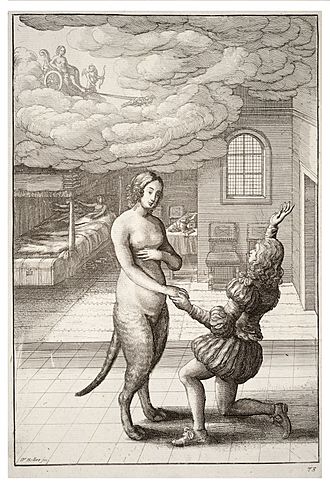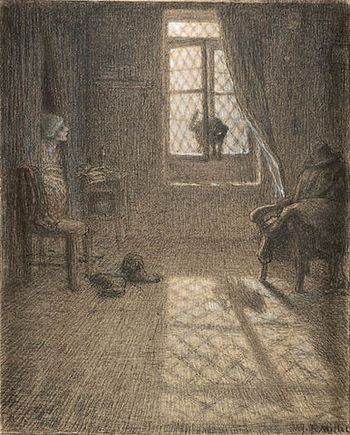The Mouse Turned into a Maid facts for kids
The mouse turned into a maid is a very old story, or fable, that started in India. It traveled all the way to Europe and also became known in places like Japan and Korea. This fable is about searching for the right partner. It shows that sometimes, the best match is someone who is just like you.
Another old fable, "Venus and the Cat," is similar. In this story, a goddess changes a cat into a woman. But it teaches that it's hard to change who you truly are, deep down. Both fables have been told in many ways through books, stories, and art.
The Mouse-Maid: A Tale of True Nature
The story from the ancient Indian book Panchatantra tells about a mouse. A bird drops the mouse, and a holy man catches it. He uses his magic to turn the mouse into a little girl and raises her as his own daughter.
When she grows up, the holy man wants her to marry someone powerful. He first asks the Sun to marry her. But the Sun says the Cloud is more powerful because it can cover the Sun. So, the holy man asks the Cloud. The Cloud says the Wind is stronger because it can blow clouds around. Then he asks the Wind, but the Wind says the Mountain is stronger because it can block the wind. Finally, he asks the Mountain. The Mountain says that even it can be tunneled through by a tiny mouse!
At this point, the girl feels a strong connection to the mouse. She realizes she belongs with someone like her original self. So, the holy man changes her back into a mouse. She then goes to live with her mouse husband in his hole.
This old Indian story was later translated into other languages like Pahlavi and Arabic. Before it reached Europe, a similar story appeared in Marie de France's book Ysopet. This version was a warning against trying to marry someone from a much higher social class. In her story, a field mouse wants to marry the Sun's daughter. The Sun sends him to the Cloud, then the Wind, then a tower, and finally to a mouse that can dig under the tower. This teaches the ambitious mouse a lesson about staying in his own place.
Other versions of this story exist too. In Romania, a rat tries to visit God. He asks the sun and clouds for directions, but they won't talk to him. Then he asks the wind, which picks him up and drops him on an ant-hill. The story ends by saying, 'and there he found his level.' This means he ended up where he belonged. Japanese and Korean versions also have a father looking for a powerful husband for his daughter. He goes to the sun, cloud, and wind, only to learn that everyone has their own place in the world. These versions often involve animals like rats or moles and don't include the magical transformation.
Later, the French writer Jean de La Fontaine wrote his own version called "The Mouse Metamorphosed into a Maid" (Book IX, Fable 7). He mentioned the story's Indian roots, saying a Brahmin (a holy man) raised the mouse. La Fontaine joked about the idea of changing a creature's true nature. He wrote that the souls of humans and mice are very different. He believed that nothing, not even magic, can change the way Heaven planned things to be.
The American poet Marianne Moore was inspired by La Fontaine's fable. In 1954, she wrote her own poem about it. She said that we are who we were born to be, and our traits stay true to nature's plan. She believed that no magic can make us change from what we are meant to be. This poem was later turned into a song by the British composer Alexander Goehr in 1993. The famous artist Marc Chagall also made an etching (a type of print) about this fable between 1927 and 1930.
Venus and the Cat: Nature's True Colors

The Western version of this kind of fable is "Venus and the Cat." This story comes from ancient Greek and Roman times. It teaches that our true nature is stronger than how we are raised or taught.
In many versions of this story, a man is in love with his pet cat. He asks the goddess Venus (or Aphrodite) to turn his cat into a woman so he can marry her. The goddess agrees. But on their wedding night, Venus tests the new woman. She lets a mouse into the bedroom. The woman, even though she looks human, can't help but chase the mouse! This shows she is still a cat at heart.
In an older Greek version by Babrius, it's a weasel that falls in love with a man. She asks Aphrodite to turn her into a human. But during the wedding feast, she runs off to chase a mouse. People in ancient times thought this story was connected to a Greek saying: "a saffron (wedding) robe does not suit a weasel." This saying means that you can't change your basic nature, no matter the situation.
When the fable was retold in a Latin poem by Hieronymus Osius, it spent a lot of time talking about how hard it is to change one's basic nature. The poem said it's "difficult to elicit, illicit, change where nature’s innate."
Jean de La Fontaine also wrote a separate version of this fable called "The cat changed into a woman" (Book II, Fable 18). He thought deeply about the idea of change. He wrote that nature is very strong and hard to change. He believed that old habits are very difficult to break, no matter how much you try.
Even though La Fontaine didn't mention Venus in his fable, she appears in Christopher Pitt's "The Fable of the Young Man and his Cat." Pitt's version makes fun of women a bit. The transformed cat acts like a fashionable lady of the 1700s. But when she goes back to being a cat, Pitt says it's like she's returning to her natural female ways. In his story, the foolish man is left by the cat-woman, instead of the goddess punishing her.
Artistic Interpretations
La Fontaine's fable also inspired music. Jacques Offenbach wrote a short opera called La Chatte Metamorphosée en Femme (The Cat Changed into a Woman) in 1858. It's a funny story about a man who loves his cat. His cousin wants to marry him, so she pretends to be the cat, changed into a woman.
However, the ballet La Chatte (The Cat) by Henri Sauguet in 1927 has a sadder ending. In this ballet, the goddess Aphrodite turns the woman back into a cat. This happens after the woman leaves her lover to chase a mouse, and he dies of sadness.
There was an even earlier ballet with the same name in 1837. It had music by Alexandre Montfort and dance by Jean Coralli. The famous dancer Fanny Elssler played the main role. This ballet not only inspired Offenbach's opera but also led to Frederick Ashton's ballet in 1985, created for a celebration of Fanny Elssler. In 1999, the French composer Isabelle Aboulker set La Fontaine's fable to music for piano and a singer.

Many artists have also drawn or sculpted these fables. Jean-François Millet made a drawing around 1858. It shows a black cat with bright eyes looking at a surprised man peeking from his bed curtains. Later, in 1908, Ferdinand Faivre created a marble sculpture. In his art, the woman seems to be gently looking at and stroking the mouse, rather than hunting it.
The subject also appeared in Marc Chagall's etchings of La Fontaine's fables. Plate 25 shows a figure with a cat's head but a woman's body, looking out from the picture while leaning on a small table. Four centuries earlier, Wenceslas Hollar also drew the transformation scene for a book called The Fables of Aesop in 1668.

